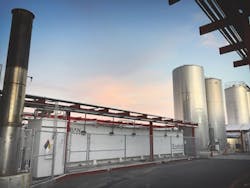The Water-Energy Purchase Agreement
Distributed solutions for process water treatment, renewable energy generation and water reuse increase critical supply chain security for industrial businesses that often face high energy and process water discharge costs, as well as capped supply for production. However, onsite solutions often are perceived as cost-prohibitive, particularly for growing businesses in rapidly changing industries such as the craft beer industry.
Cambrian Innovation developed the Water-Energy Purchase Agreement (WEPA) to make accessible onsite, distributed solutions for process water treatment and water reuse. Based on the solar industry’s successful power purchase agreement (PPA), it offers an alternative for capital purchases, leases and operating contracts for process water treatment, renewable energy generation and water reuse.
In December 2016, Lagunitas Brewing Co. became the first to enter into WEPA, which will save the brewery a projected $22.5 million over its lifecycle.
Developing WEPA
When discussing process water management with prospective customers in the craft beer industry, Cambrian Innovation noticed that customers were hesitant to invest in equipment tangential to the brewing process, even if the return on investment was good, and that customers were interested in outsourcing process water treatment. Customers did not want to be in the business of process water treatment, and preferred to hand all treatment operations to a third party, giving them the time and energy to make, market and sell their beer.
Those concerns resulted in the model for the industrial process water sector similar to PPA, which is credited with unlocking the benefit of clean solar initiatives at the consumer level. Launched in late 2015, the model eliminates upfront capital costs and risks.
A host customer purchases treatment services on a per-gallon basis, and Cambrian Innovation is responsible for the ownership, design, construction, installation and operation of the system. Local, state and federal incentives are monetized, and that value is passed to the customer through monthly rates.
Power of Technology
The EcoVolt Reactor is an enhanced anaerobic digester that uses electromethanogenesis to treat process water while generating renewable resources. Electromethanogenesis enhances the anaerobic treatment process to stabilize system operation, improve biogas production, and enable remote monitoring and automation of the treatment process.
The reactor achieves 80% to 90% removal of biological oxygen demand (BOD) and is energy-positive through the generation of biogas, which becomes a source of renewable electricity or heat for the facility. Figure 1 shows the performance of one reactor over two months, through typical fluctuations seen at breweries.
The product suite also includes a membrane bioreactor (MBR) and the EcoVolt MINI. MBRs are aerobic digesters that use fine bubble aeration and ultrafiltration to remove BOD and total suspended solids. It can be used as a standalone solution or in conjunction with another reactor for wastewater treatment and water reuse.
The EcoVolt MINI is designed for smaller, growing customers, and combines anaerobic and aerobic technology in one container. The prefabricated products also are modular and containerized for a small physical footprint and flexible capacity expansion. These aspects mitigate risk associated with installation, ownership and operation.
Model in Action
Lagunitas Brewing Co. in Petaluma, Calif., was trucking more than 50,000 gal of high-strength wastewater to a municipal treatment plant 50 miles away. Now, its self-powered solution treats more than 120,000 gal per day (gpd) of spent process water and produces more than 80,000 gpd of clean, recycled water. This cut the brewery’s water footprint by 40% while generating 130 kW of electrical power and 40,000 therms of heat per year.
The success led Lagunitas to select EcoVolt for its new brewery in Azusa, Calif. This time, Lagunitas will avoid an upfront capital cost with WEPA. Cambrian Innovation will own, install and operate the solution, which will be capable of producing an estimated 300,000 gpd of recycled water, more than 2,300,000 kWh per year of gross renewable electricity and 130,000 therms per year of gross renewable heat.
As the brewery increases production at the Azusa facility to more than one million barrels per year, it will look to treat increased process water flows through the incremental installation of additional modules.
Financing models like WEPA save industrial businesses money and reduce the perceived risk associated with clean technology. As water scarcity becomes more acute, the model will help industrial businesses stabilize costs amidst growing water market volatility.

